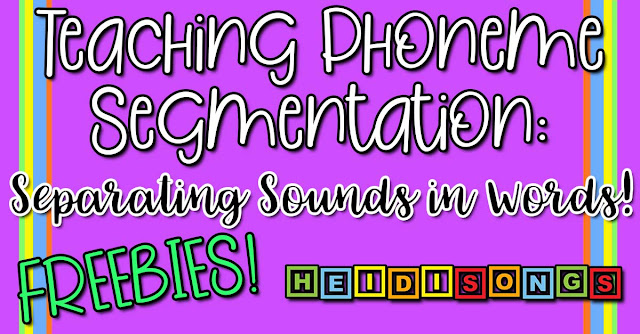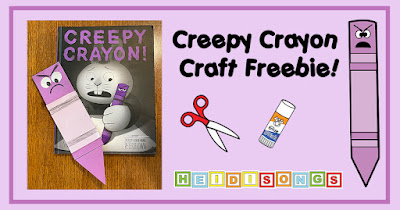Building Primary Math Concepts
Have you heard the news? We've Moved to HeidiSongs.tv!
Our new website features an online video streaming service, updated blog posts at Heidisongs.blog, and a wealth of fresh resources designed to make learning even more fun and engaging.
You can also continue shopping for our educational products there and at our Teachers Pay Teachers store!
Head over to HeidiSongs.tv now and explore all the exciting new features.
See you there!
__________________________________________________________________________
In most primary classrooms today, teachers seem to spend the majority of their time on Language Arts, with Math coming in a close second on the priority list. This is definitely what happens in my classroom! Because language arts instruction is so important and seems to eat up so much time, I find that it is all the more crucial to make sure that my math instruction is effective and is delivered efficiently. I use math manipulatives in small groups daily to develop math concepts and understandings, and then use the songs from my HeidiSongs.tv Streaming Videos to help reinforce and review these math concepts at other times of the day as well.
The songs in the Musical Math collection are particularly helpful in reviewing the academic vocabulary associated with these math concepts. For example, when introducing a concept such as patterning, I first show the children some patterns in a whole group setting using manipulatives with magnets on them, placing them on a magnetic white board easel. We talk about what kinds of patterns I am making, then name these patterns with letters, such as an AB pattern. Then we all stand up and sing the AB pattern song. Then, when we break into small groups for practice, the children each get to make their own patterns and again attempt to label them with letters. When in the small groups, I may sing some of the songs softly that we learned to help the children remember what it is that we are trying to do. The songs help link the concrete math concepts that we are learning with the abstract math vocabulary that they must also learn. Once they have a solid label for each concept in their heads and can build their own examples of these patterns, true learning has taken place. We will work on a concept such as patterning for several weeks, and sing the songs on and off again during the actual math lessons, during transition times, or whenever the kids need a chance to get up and move a little to get those wiggles out! (Here is the old version of the song so you can hear the song I'm talking about. Know that the version on our streaming site looks more like the video above.)
For example, in the AAB pattern song, they sing, “Chug, chug, caboose! Chug, chug, caboose! Duck, duck, goose! Duck, duck, goose!” all with movements for each one. It’s definitely a favorite activity! Musical Math also has songs like this for sorting, comparing sets (more, less, and equal), coin recognition, skip counting, counting to 100, addition, and subtraction. But no matter what the concept, my basic lesson plan is to first introduce the concept whole group with magnetic manipulatives, sing the song, and then work on the concept in small groups with manipulatives. After that, if the skill must be transferred to paper, then we work on that, too. Meanwhile, we keep reviewing the songs as often as time will permit. Hopefully, when the children hear the songs, they will be visualizing their experiences with the manipulatives in their heads, and connecting this learning to the math vocabulary that the song is about.
For some children, especially those with limited preschool experiences, simple shape and number recognition from zero to ten is also a problem. Because of this, I developed the Number Jumble Songs Jumpin’ Numbers and Shakin’ Shapes flashcards. The flashcards each have a character embedded into each number or shape. This character jogs the child’s memory to help him remember a motion and the name of the number or shape. For example, there is a monkey on the number eight card. When the children see it, they are coached to say, “Eight!” while making a monkey motion. Often, if they cannot immediately remember the name of the numeral, when they make the motion the memory is jogged and the number often pops right out of their mouths, much to their surprise! The movement of the hands work to activate the muscle memory that some children need to help them remember the name of that number or shape. As an added bonus, many of the motions mimic the form of the number or shape. For example, the motion for number eight with the hands overhead and the knees bent forms the shape of the eight. The motion for number four is to hop with two hands up on your head like bunny ears; this is meant to look like the two top lines on a number four.
The learning that takes place here is as easy and natural for a child as learning a nursery rhyme such as “The Eency Weency Spider.” As soon as a child’s hands start making motion of the spider going up the spout, they begin to sing that little song, rarely forgetting a single word. I would be very surprised if most adults reading this cannot remember this little children’s song as well! This is because the movement combined with the music put that little song right into long term memory; it will probably be in most adults memories forever!
What I have done with the these specially designed number and shape cards is give each one a motion and a song that also incorporates those motions. For example, the Number Eight song goes like this, sung to the tune of “This is the Way the Ladies Ride.” (Again, this is the old version of the song video so you can hear it, but know that the version on our streaming site looks more like the updated animated videos.)
Scritchity scratch goes number eight,
Number eight, number eight!
Scritchity scratch goes number eight,
Monkey number eight!
I always try to hold the flashcard in my hand while my class sings the number songs. We also drill the children on the flashcards. After a couple of weeks, we simply change to plain old number and shape flashcards and drill the children in the same way; by having them respond verbally and physically with the associated motion, even though the character is not there. Usually, in about two or three weeks, my whole class knows the numbers and shapes out of order on plain old flashcards. (If there is a straggler or two still working on a couple of isolated numbers, I pull the children out and work with them individually on it during playtime. At the point that most of the kids know the numbers and shapes, we stop singing those songs and switch over to the Musical Math songs instead. After that, we sing the number songs for zero through ten “by request only.” But since the numbers and shapes are useful to them, I have never had a child forget any of them during the course of the school year.
At that point, learning to identify and write the numbers in the teens and twenties is a whole new challenge for many! Once again, songs and movements are my tool and have come to my rescue many a time! The Eleven Song is one case in point. One day, when helping my children write their numbers, I found myself repeating over and over that to make a number eleven, they would need to write a one and a one. I said this so many times over during the course of the day during that four group rotation that after a while, this little song just popped out of my mouth from out of nowhere! It went like this: (sung to the tune of The Fox Hunt)
Eleven, eleven, eleven!
A one, a one, I’m done!
Suddenly, children that could not remember how to make a number eleven before could now remember it- every time! I was surprised that it worked so well! Soon, everyone in my class knew The Eleven Song, and everyone could identify and write number eleven. Shortly after that, a little boy asked me to teach them The Twelve Song! I was caught off guard, and said, “I don’t have a Twelve Song!” Then one little girl with a whole lot of faith in her teacher, said, “Maybe you could go home tonight and write one, and then come back and teach it to us tomorrow!” That year, I managed to stay one number song ahead of my class each week, writing a song for each number from 11-30- and the concept for Jumpin’ Numbers Vol. 2 was born, which is now apart of the same Number Jumble 0-30 video collection! These days, I use these songs during math instruction, during transition times, when they need to get their wiggles out, and also during our calendar time. So, on the twelfth day of the month, we sing the Twelve Song, etc. It’s a fun way to keep reviewing as we go! I have also found it useful to choose a helper of the day to build that number with magnetic base ten blocks and write the number above it on my white board easel. It’s a great way to continually reinforce how to make those numbers and record them. We also practice building those larger numbers in small groups with manipulatives and recording the number.
In addition, I have found that the children also benefit from writing the numbers as the songs play. I think that when the kids are done with all of this, they have a real understanding of what it that number really is! We have number writing songs in the Number Jumble collection as well!
----------------------------------
Follow me! Did you enjoy this post? Do me a favor and share it with your friends! And follow this blog by signing up for my email updates, or follow on Bloglovin', or follow me on TPT! I'm also on Pinterest, Facebook, Twitter, Instagram, Google+ and YouTube, too! Don't forget to sign up for our email newsletter (at the bottom of this page) for special deals and promo codes that you won't find out about anywhere else.
----------------------------------
Follow me! Did you enjoy this post? Do me a favor and share it with your friends! And follow this blog by signing up for my email updates, or follow on Bloglovin', or follow me on TPT! I'm also on Pinterest, Facebook, Twitter, Instagram, Google+ and YouTube, too! Don't forget to sign up for our email newsletter (at the bottom of this page) for special deals and promo codes that you won't find out about anywhere else.









